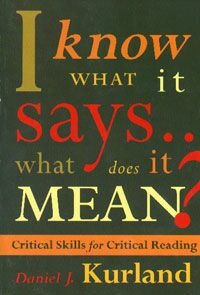I
Know What It Says...What Does It Mean?
|

|
Wadsworth Publishing
NOTE: The book is now out of print. To obtain a copy, try Amazon.com, or contact the author to purchase a .pdf version with teachers manual Paperbound � 1995
|
This renegade book is a breath of fresh air for students who need to develop basic skills, but do not require remedial training. It contains a variety of timely readings and examples designed to capture students' interest as they learn to read critically.
- Provocative articles covering issues such as gays in the military and the Ku Klux Klan.
- Exercises that appear throughout each chapter.
- Key points that are highlighted in boxes for easy reference.
- An appendix on ''Resources on Critical Reading.''
- Exercises that appear throughout each chapter.
- Key points that are highlighted in boxes for easy reference.
- An appendix on ''Resources on Critical Reading.''
� Preface.
� Introduction.
� Section 1: Reading: An Active, Reflective, Problem-Solving Activity.
1. Analysis--Making the Complex Simple.
2. Prior Knowledge and Meaning--The Art of Controlled Inference.
3. I Know What It Says, But What Does It Mean?--Inferring Meaning.
� Section 2: Critical Reading of a Text as a Whole.
5. The Text as Portrayal--Choices.
6. A Rose Is a Rose Is a Rose. or Is It?--What Examples Are Examples Of.
7. ''Know That We Have Divided Into Three Our Kingdom ''--Identifying Analytic Parts.
8. Inferring Meaning from Relationships--Inference Equations.
9. Freedom Fighters or Terrorists?--The Choice of Language.
10. ''Authoritative Sources Said . . . ''--Invoking Belief and Acceptance.
11. Critical Thinking--Going Beyond an Interpretation.
� Section 3: Tactics and Techniques--Putting It All Together.
12. Restatement, Description, and Interpretation--A Review.
13. Sample Analyses.
� Texts For Analysis.
I. Contrasts. A. The Ku Klux Klan. B. The Assassination of Malcolm X. C. Gays and the Military. D. A Question of Ethics.
II. Petitions, Arguments and Pleas.
III. Contemporary Issues.
� Appendixes: Resources for Critical Reading.
1. Outlining.
2. The General/Specific Relationship.
3. The Role Model of Paragraph Structure.
4. The Descriptive Model of Paragraph Structure.
5. The Relationship Model of Paragraph Structure.
6. Logic and Statistics. Notes. Index.